
Warm-season grasses grow best in areas with warm summers and mild winters. These hardy grasses can take the heat and have one growing season, from late spring through early fall. If you live across the southern or middle band of the U.S., warm-season grasses are a prime candidate on your grass type ballot.
Where do warm-season grasses grow?
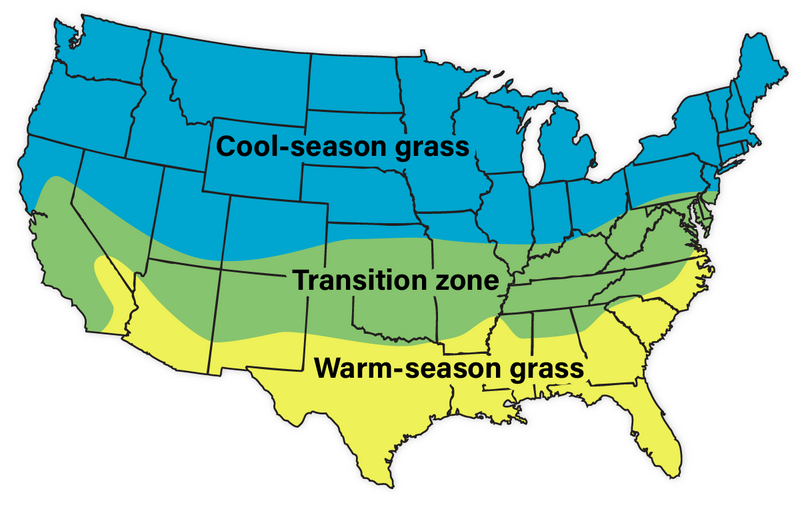
If you live in the southern states or along the middle belt of the country, you’ve likely seen warm-season grass. As you can see from the map, warm-season grasses grow best in the warm-season zone and along the transition zone.
Warm-season grasses grow best in warmer climates with hot summers and mild winters. Most warm-season turf will go dormant or brown in the winter. If you live in an area with warm winters, such as South Florida, your grass may continue to grow and stay green throughout the winter.
Which types of warm-season grasses can I plant?
Here are the most common warm-season turfgrass types in the U.S.:
- Bahiagrass
- Bermudagrass
- Buffalograss
- Carpetgrass
- Centipedegrass
- St. Augustinegrass
- Zoysiagrass
These links will take you to our comprehensive grass type guides. If you want to know how to select, grow, and care for each grass, check out the links above for more information.
If you have perennial ryegrass, Kentucky bluegrass, tall fescue, or fine fescue in your lawn, this is not the guide for you. Check out our “Guide to Cool-Season Grasses” instead.
Similarly, we won’t discuss warm-season native grasses such as Indiangrass, switchgrass, little bluestem, or big bluestem. These usually grow on prairies and not home lawns. These don’t require the same type of intense weekly maintenance as turfgrass.
You may be surprised to know that native grasses, such as buffalograss, often have roots that extend several feet into the soil, while non-native turfgrass roots extend only a few inches deep. (Buffalograss is the only native grass on our list.)
How to grow warm-season grass
Let’s learn the pros and cons of seed, sod, and hydroseed in a warm-season lawn.
| Grass type | Seed | Sod |
| Bahia | ✓ | ✓ |
| Bermuda (common and improved common varieties) | ✓ | most often seeded |
| Bermuda (hybrid), sprigs/plugs are other options | ✗ | ✓ |
| Buffalo, plugs are another option | ✓ | ✓ |
| Centipede, sprigs/plugs are other options | ✓ | ✓ |
| Carpetgrass, sprigs are another option | ✓ | ✗ |
| St. Augustine, sprigs/plugs are other options | ✗ | ✓ |
| Zoysia, springs/plugs are other options, but they’re not recommended | ✓ possible but not recommended | ✓ |
Before you plant
Do a soil test on your lawn before you put down grass. You’re making a large investment in time, seed or sod, and irrigation. Your soil test will measure soil pH, macronutrients, and micronutrients. If the lawn needs more or less of any of these things, a soil test is the only way to know.
Word to the wise: Before you throw down a new lawn, know that warm-season grasses must have full sun. If you have even partial shade, consider St. Augustine or a grass alternative (ornamentals, mulch, or ground cover). St. Augustine is the only warm-season grass that tolerates moderate shade (some cultivars more than others).
Seed
Most warm-season grasses are available as seed. If you’re tight on funds, seed is the way to go. Seeding a lawn is less expensive than buying sod and is a doable DIY project for most homeowners.
When do I plant warm-season grass? Late spring and early summer, when it’s starting its upward growth curve.
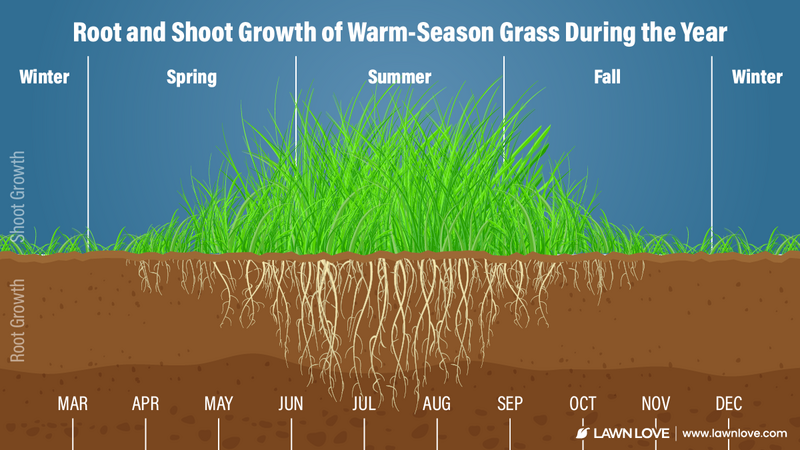
How often do I water? Set your sprinklers to come on two to three times per day to keep the soil moist but not flooded until the grass germinates.
To learn how to seed a lawn successfully, check out our articles, “Growing Grass From Scratch: From Soil to Lush Lawn and “How to Plant Grass Seed in 10 Simple Steps.”
Sod
Warm-season sod can be put down nearly any time of year, but late spring and early summer are ideal. It’s best to avoid the middle of summer and the middle of winter if possible, although it can be done with proper preparation and watering.
Sod is more expensive than seed, but for many, the “instant lawn” is worth the price. It’ll take sod from two to four weeks for the roots to establish. Once the roots are established, you can do the first mow on your new lawn.
Pro Tip: Do a “tug test” to see when the roots have taken hold. Tug on a handful of grass blades. If the sod lifts from the soil, it needs more time to root. If the sod doesn’t budge, you’re good to mow.
Hydroseed
If you have a large property that needs turf, hydroseeding may be your best bet. Sod and spreading seed work best for standard-sized and smaller lawns. Larger acreages and slopes benefit from a technique called hydroseeding.
What is hydroseeding? Simple: A mixture of grass seed, fertilizer, water, and stabilizers that form a “grass slurry.” This slurry is like a grass milkshake that holds the grass seed in place as it germinates. As with seed, you’ll need to set your sprinklers to run several times per day to keep the mixture moist.
Check out our article, “Hydroseeding: How to Spray Grass Seed on Your Lawn” to learn more.
How to mow warm-season grass
If you think mowing is an insignificant part of your lawn care routine, we hope to convince you otherwise. Mowing is a small thing that makes a big difference in the life and health of your lawn. Here are a few key tips to help your grass get off to a good start.
One-third rule of mowing
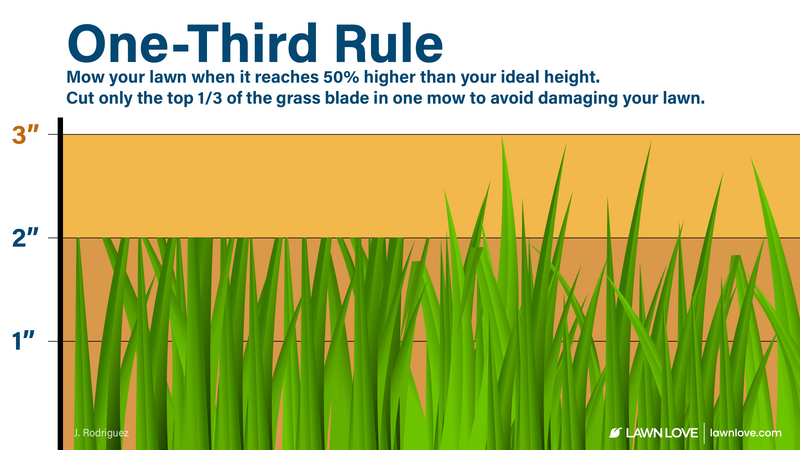
If there were a Golden Rule of Mowing, it is this: Take off no more than one-third of the blade per mow. If you remove more than this, you place too much stress on the grass. It’s a little thing that makes a big difference, just like that other golden rule.
Mow at the correct height
Check out this handy chart to see how tall to mow your warm-season grass:
| Grass Type | Suggested Height (inches) | Mow at This Height (inches) |
| Bahia | 3-4 | 4-5.25 |
| Bermuda | 1-2 | 1.25-2.5 |
| Buffalo | 2-4 | 2.5-5.25 |
| Carpet | 1-2 | 1.25-2.5 |
| Centipede | 1.5-2 | 2-2.5 |
| St. Augustine | 2.5-4 Dwarf varieties 2.5-3, standard varieties 3-4 | 3.25-5.25 |
| Zoysia | 1-2.5 | 1.25-3.25 |
* Add a half-inch to these heights in the summer or in areas with more shade.
Leave the clippings
Another small thing that makes a big difference is this: Use a mulching mower and leave the clippings on the grass as you mow. “Grasscycling,” as it’s called, can reduce your fertilizer use by up to 25% each year.
Word to the wise: There are a few cases when you’ll want to bag your clippings. It’s best to bag the grass clippings if:
✗ You have fungus in the lawn (Don’t compost)
✗ Leaves cover more than 50% of the lawn’s surface (Compost, and mow more often going forward. Mulched leaves are a rich source of nutrients for your lawn.)
✗ Weeds in the lawn have developed seed heads (Don’t compost)
✗ The lawn is exceptionally tall (Compost)
Use sharp blades
You wouldn’t pay your hairdresser to cut your hair with a dull pair of scissors. Your lawn expects no less from you. Keep an eye on the grass. When the blades look torn instead of cleanly cut, it’s time to sharpen the blades.
Alter your mowing pattern
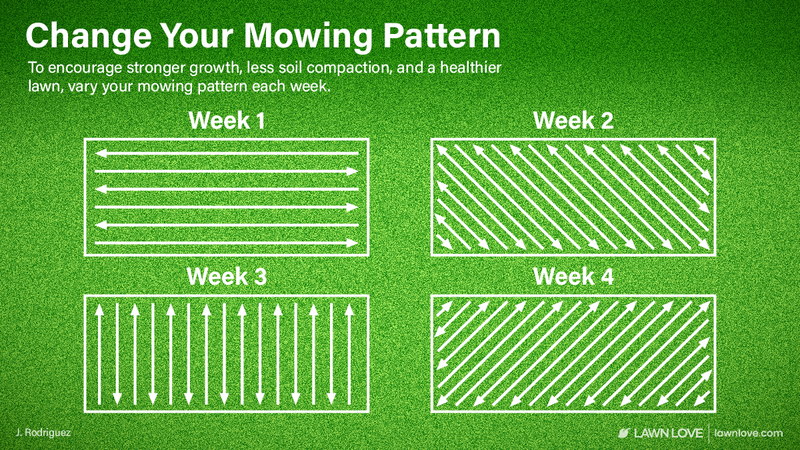
Your grass enjoys a bit of variety from time to time — each time you mow, actually. Vary your mowing patterns each week to reduce soil compaction and prevent a grain from developing (when the grass leans in a particular direction). This simple practice helps create a more uniform, professional-looking lawn.
- Week 1: Mow horizontally
- Week 2: Mow diagonally — start in one corner of the yard
- Week 3: Mow vertically
- Week 4: Mow diagonally — start in the opposite corner of the yard than Week 2
Mow when it’s dry
Try to mow when the grass is dry, if possible. There are times when you’ll have to mow when the ground is still damp. In general, wait until after the ground has dried out before you mow.
There are many benefits to mowing a dry lawn:
✓ Mowing a wet lawn increases the risk of soil compaction and ruts
✓ A wet mow leaves clumps of grass on your mower deck and on the lawn
✓ Wet grass can’t recirculate well in a mulching mower deck, which means a poorer cut
How to maintain warm-season grass
Water
Once a lawn is established, give the lawn 1 inch of water per week as a general rule. Sandy soils benefit from two or three lighter waterings since these soils don’t retain water as well. For most other soils, deep and infrequent watering is the rule to live by.
Deep and infrequent irrigation (once per week if there’s no rain) encourages the root system to grow deeper into the soil in search of water. This deep rooting strengthens the grass and makes it more resilient against disease, insects, and of course, makes it more drought-resistant.
Cardinal rules of watering:
- Water early, and finish no later than 10 a.m. Some turf specialists recommend setting your sprinklers to start before the sun comes up. This will allow even greater time for the grass to dry, which reduces the likelihood of fungus.
- Let the grass tell you when to water. If you see the grass wilt or change color, it’s time for a drink. If you follow this rule, you may notice that it needs less or more water than 1 inch per week.
Fertilize
Fertilize warm-season grass from late spring through the summer months and into early fall. In other words, during its growth period. (Dormancy, or winter, is not the time to fertilize.) A soil test will make recommendations on how much your lawn needs. If you haven’t taken a soil test, follow the guidelines on any basic turf fertilizer.
Start your first application when the soil temperatures at 4 inches deep are 65 degrees Fahrenheit and rising. (See this recommendation on this warm-season lawn calendar from the University of Georgia.) Apply from .5 to 1 pound of nitrogen per 1,000 square feet at each application. Apply every four to eight weeks. Your final application should be in late summer or early fall.
How much fertilizer should you apply in total? It depends on the type of grass (and recommendations may vary slightly by state as well). Don’t want a high-maintenance lawn? Fertilize on the lower end of the ranges listed here. Here are some basic warm-season fertilizer guidelines:
| Grass type | How Much Nitrogen To Use (per 1,000 square feet per year) |
| Bahia | 1-4 pounds |
| Bermuda | 1-4.5 pounds |
| Buffalograss | 0.5-2 pounds |
| Centipede | 0.5-2 pounds |
| Carpetgrass | Optional: 0.5-2 pounds |
| St. Augustine | 2-6 pounds |
| Zoysia | 0.5-2.5 pounds |
Some fertilizers should be watered in; some say to wait. Check your package label for directions.
For local advice, search for the Cooperative Extension’s lawn maintenance calendars in your state.
To consider: Some cities, in Florida in particular, have fertilizer blackout dates. Check with your city before you apply.
Final tip: If you want a green lawn without the extra growth that nitrogen provides, consider supplemental iron. Apply every two to four weeks in the summer as long as the grass is dry and temps are below 80 degrees. Water in after you apply.
Aerate
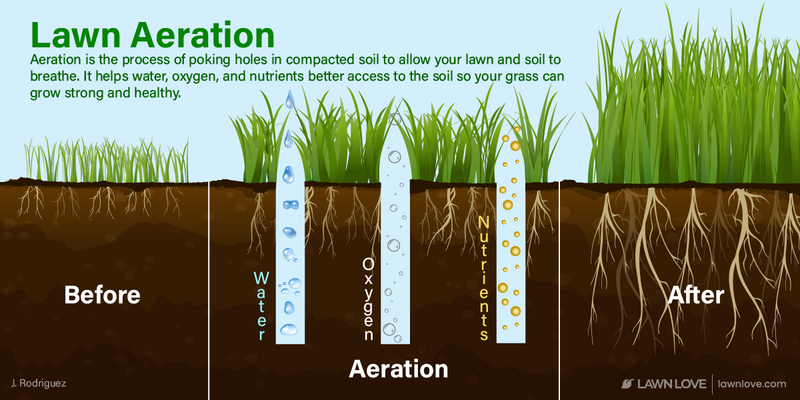
If you have heavy, clay soil, aeration is your new best friend. Rent a core aeration machine or hire out the job in the late spring or early summer.
Core aeration pulls plugs of soil from the lawn and opens up its “pores.” When more air, water, and nutrients reach the roots, you have better water and nutrient infiltration and stronger roots. This means better drought tolerance and a healthier lawn overall.
Dethatch

A little thatch is a good thing, but too much and your lawn will decline.
Warm-season grasses susceptible to thatch:
- Bermudagrass
- Carpetgrass
- Centipedegrass
- St. Augustinegrass
- Zoysiagrass
Thatch is like a sponge that sits on top of your soil. This undecomposed layer of organic matter (grass, leaves, roots) prevents air, water, and nutrients from reaching your soil.
Once the thatch layer is above a half-inch (or 1 inch for St. Augustine), it’s time to dethatch. The best time to dethatch is also the late spring or early summer.
Overseed
Lawns thin out over time due to winterkill, disease, soil compaction, foot traffic, and other factors. The solution is simple: overseed. In the spring after greenup is the best time.
Overseeding means you throw down grass seed in areas of your existing lawn that are thin or dead.
Pro Tip: Overseed, dethatch, fertilize, and/or aerate in one fell swoop in late spring to get your lawn off to a roaring start.
Control weeds
A healthy lawn is the best defense against unwanted weeds. Most well-maintained warm-season grasses provide a full, thick lawn that crowds out many weeds. Some grasses, such as bahia and buffalograss, have a more open growth habit, and weeds will be more of an issue.
Step 1: ID your weed
If you have weeds in your lawn, so do your neighbors and other lawns in your area. Download a plant app or take a sample to your local Cooperative Extension office for a proper ID.
Step 2: Know when the weed grows
Summer annuals start growing in spring. Winter annuals germinate in late summer.
Biennial weeds grow the first year, overwinter, and set flowers and seeds the second year.
Perennial weeds live at least three years.
Step 3: To treat, or not to treat?
If you prefer not to spend time agonizing over your weeds, the best thing to do is to mow over them. Except for a few that grow low to the ground, you’ll prevent most from going to seed by just mowing.
If you want to treat the weeds pronto, there are natural and chemical solutions called post-emergents (meaning that the weed has already emerged from the soil). Or, wait and put a pre-emergent down before they germinate next season. Hand-pulling is also an option. If you choose chemicals, make sure the products you use are suited for your grass type.
Pests and diseases of warm-season grasses
Pests and diseases in warm-season grasses are sometimes a concern for homeowners. Grubs, chinch bugs, fungal diseases, and mole crickets are common nuisances. Follow the same steps we mentioned for weed control (proper ID, timing, and treatment options) for success in your lawn.
As with all lawn maintenance, the best defense against lawn diseases is a good offense. Proper ongoing management will save you from many problems later on.
If you’re too busy enjoying the warm summer weather to worry about your lawn, contact one of our local lawn care pros to keep your lawn in top form.
Main Photo Credit: FelixMittermeier | Pixabay